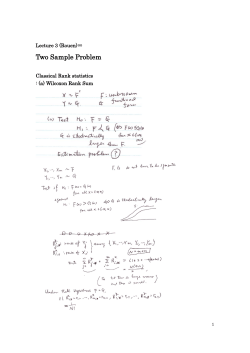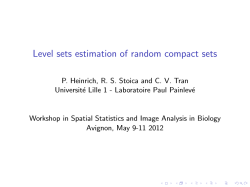
ECG751 - Econometric Methods - Fall 2014 Instructor: Denis Pelletier
ECG751 - Econometric Methods - Fall 2014 Instructor: Denis Pelletier Problem Set #3: Due on Thursday, October 30 You must perform all the econometric analysis in Matlab. Submit a copy of your code with your answers and email a copy of your code to ecg751-001-sup@wolfware.ncsu.edu. You also need to show your derivations. Unless told otherwise, use a 5% significance level. Question 1. “An unbiased estimator is not necessarily consistent. A consistent estimator is not necessarily unbiased even at the limit when the sample size goes to infinity.” 1.1. Give an example for the first proposition. 1.2. Consider an estimator θˆN such that Pr(θˆN = θ) = (N − 1)/N and Pr(θˆN = N ) = 1/N . Prove that θˆN is an example of the second proposition. Question 2. What is the covariance matrix between the GLS estimator and the difference between the GLS and OLS estimator estimator, i.e. Cov(βˆGLS , βˆGLS − βˆOLS )? Question 3. Consider the usual linear regression model: yi = β1 x1i + · · · + βK XKi + i , (1) where all the usual assumptions are satisfied, including i following a normal distribution. To test H0 : β1 = 0 against H1 : β1 6= 0 you consider the following t statistic: t= βˆ1 − 0 , se( ˜ βˆ1 ) (2) p where βˆ1 is the OLS estimate of Equation (1), se( ˜ βˆ1 ) = σ ˜ 2 [(X 0 X)−1 ]11 , σ ˜ 2 = ˜0 ˜/(N −(K −1)) and ˜ are the residuals of the model in Equation (1) obtained by restricting β1 to be zero (we removed x1i from the model). Explain why using σ ˜ 2 instead of the usual σ ˆ 2 = ˆ0 ˆ/(N −K) for the computation of the standard error affects the distribution of the t statistic under H0 when N is fixed but not asymptotically. Question 4. Let us consider the following setup. The model is yi = β1 xi + i with i = 1, . . . , N . The error term i is i.i.d. N (0, 100). The regressor xi consist of i.i.d. draws from a uniform distribution on the [0; 2] interval. We estimate β1 by OLS and we test H0 : β1 = 0 against H1 : β1 6= 0 using the usual t statistic. Since the error term has a normal distribution we know that it has a Student-t distribution with N − 1 degrees of freedom. Set the seed of the random number generator (see note below). In this question, you need to compute the power function of this test through simulations. For a given value of N and a given value of β1 : you simulate data, estimate β1 and test H0 against H1 . You replicate this procedure 1,000 times and count the fraction of replications for which you can reject H0 . Do all of this for three different sample sizes, N = 10, 50, 500, and for β1 = −3, −2.9, . . . , 2.9, 3. 1 To report your results generate a figure where you plot a curve for each sample size (fraction of rejection against the value of β1 ). Comment the results. Do you get expected results? To do all this in Matlab, you may need the following command: • The function to draw from a N (0, 1) is “randn”. • The function to draw from a Uniform density on the interval [0; 1] is “rand”. • To create a 1 if some condition is true or 0 if it is false, you can use logical operators. For example, the line “b = (x¿2)” will assign the value 1 to b if x is greater than 2, otherwise b will take the value zero. 2
© Copyright 2025





















